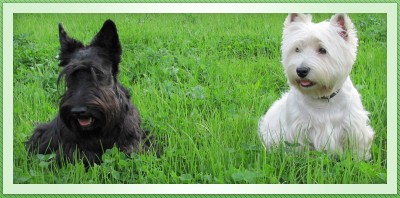WHWT
Origin
West Highland White Terriers The West Highland White Terrier originates from Poltalloch, Scotland and was once called the Poltalloch Terrier and later was called the Roseneath Terrier, named after the Duke of Argyll?s estate. The breed came about in the mid 19th century when a Scottish breeder of the Cairn Terrier whelped some white pups in his litters. Those pups were selected and bred to obtain the West Highland White Terrier, which is simply a white Cairn. The West Highland was first shown in the USA in 1906 and first recognized by the AKC in 1908. In 1909 the breeds name was changed from the Roseneath Terrier to the West Highland White Terrier. Like the Cairn, the Westie was originally bred for controlling the population of rats, fox, badger, otter and other vermin.
Temperament
West Highland White Terriers are game and hardy little terriers, which are easy to train. They are fairly friendly toward strangers and get along well with children. Easy dog to travel with. They are lively and extremely self-assured toward other dogs, but will not pick fights, if their owners know how to display proper leadership. They may chase a cat for fun, and need to be corrected if they do attempt this. Robust, friendly and spirited. Westies just love companionship. Despite its size, they make a very good watchdog. The Westie likes to dig and bark. If a Westie is allowed to become the pack leader, they may snap when irritated and be combative with other dogs. A lack of leadership on the owners part can cause many behavior problems, such as biting, guarding food and furniture. A Westie who has an owner who knows how to display firm, confident, consistent, leadership will not experience these behavioral problems. These problems can be corrected once the owner becomes the dogs true pack leader. Do not allow the Westie to develop Small Dog Syndrome. Living Conditions West Highland White Terriers are suitable for people in towns and cities as well as in the country. They are very active indoors and will do okay without a yard. These little dogs, need a daily walk. Play will take care of a lot of their exercise needs, however, as with all breeds, play will not fulfill their primal instinct to walk. Dogs who do not get to go on daily walks are more likely to display behavior problems. They will also enjoy a good romp in a safe open area off lead, such as a large fenced in yard.
Grooming
The harsh, straight, short-haired double coat is fairly easy to groom and sheds little to no hair. Simply brush regularly with a stiff bristle brush. Brushing should keep the coat clean, so bathe only when necessary. Trim around the ears and eyes with blunt-nosed scissors. The whole coat should be trimmed about every four months and stripped twice a year


